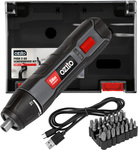Bunnings price-matching ALDI's upcoming Ferrex 3.6V Li-ion Screwdriver Kit
Features
- Push 2 Go Function - Push forward to drive screws automatically
- Push 2 Go or manual mode dual activation for extra control
- 32 Bits Included
This Cordless 3.6V Screwdriver from Ozito is great for multiple fastening jobs around the home or garage. Assemble furniture, adjust cabinet doors, fix hinges, upgrade computer parts or build RC cars with this handy tool.
The Push 2 Go function is perfect for driving screws in quick succession while the manual mode and adjustable speed can be used for fiddly applications where more control is needed.
With a selection of driving bits included and a storage case to keep everything neat and tidy, get started on your next project right out of the box.


hoping to find something similar price range but for a bigger range of sizes from mobile phones to wardrobes